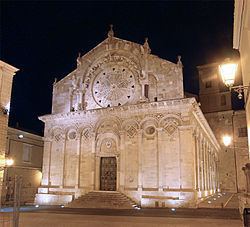Elevation 439 m (1,440 ft) | Frazioni Borgo Giardinetto Demonym(s) Troiani Postal code 71029 | |
 | ||
Weather 18°C, Wind N at 6 km/h, 54% Humidity Points of interest Troia Cathedral, Museo diocesano, Museo Civico | ||
Troia (Greek: Αῖ̓και, transliterated as Aika or Aikai or Ece; Latin: Aecae or Æcæ; also formerly Troja) is a town and comune in the province of Foggia and region of Apulia in southern Italy.
Contents
Map of 71029 Troia Province of Foggia, Italy
History
According to the legend, Troia (Aecae) was founded by the Greek hero Diomedes, who had destroyed the ancient Troy.
Aecae was mentioned both by Polybius and Livy, during the military operations of Hannibal and Quintus Fabius Maximus Verrucosus in Apulia. In common with many other Apulian cities it had joined the Carthaginians after the battle of Cannae, but was recovered by Fabius Maximus in 214 BC, though not without a regular siege. Pliny also enumerates the Aecani among the inland towns of Apulia (iii. 11); but its position is more clearly determined by the Itineraries, which place it on the Appian Way between Aequum Tuticum and Herdonia, at a distance of 29 to 31 kilometres (18 to 19 mi) from the latter city. This interval exactly accords with the position of the modern city of Troia, and confirms the statements of several chroniclers of the Middle Ages, that the latter was founded about the beginning of the 11th century, on the ruins of the ancient Aecae.
Cluverius erroneously identified Aecae with Accadia, a village in the mountains south of Bovino; but his error was rectified by Holstenius. Troia is an episcopal see, and a place of some consideration; it stands on a hill of moderate elevation, rising above the fertile plain of Apulia, and is 15 kilometres (9 mi) south of Lucera, and 22 kilometres (14 mi) southwest of Foggia.
The current Troia was founded as a fortified town in Apulia in 1018 by Basil Boiannes. It defended the entrance into the Apulian plain from the Normans. Until overshadowed by Foggia, it was an important strategic town in southern Italy, and was several times besieged, notably, by the emperors Henry II and Frederick II. After the latter's fall, it sided for the Angevines, and later, against the former, for the Aragonese.
After the Piedmontese led conquest of Southern Italy (1861), Troia rebelled and the Savoy troops intervened with the use of cannons.
Main sights
Transportation
It is the only municipality in Italy to provide free public transport.
